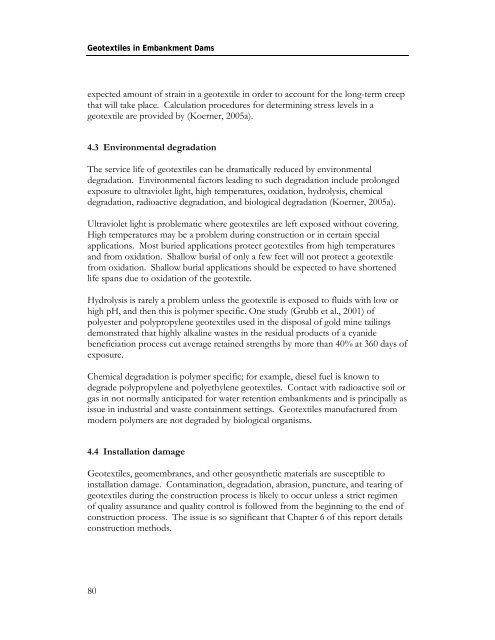Geotextiles in Embankment Dams - Association of State Dam Safety ...
Geotextiles in Embankment Dams - Association of State Dam Safety ...
Geotextiles in Embankment Dams - Association of State Dam Safety ...
Create successful ePaper yourself
Turn your PDF publications into a flip-book with our unique Google optimized e-Paper software.
<strong>Geotextiles</strong> <strong>in</strong> <strong>Embankment</strong> <strong><strong>Dam</strong>s</strong>expected amount <strong>of</strong> stra<strong>in</strong> <strong>in</strong> a geotextile <strong>in</strong> order to account for the long-term creepthat will take place. Calculation procedures for determ<strong>in</strong><strong>in</strong>g stress levels <strong>in</strong> ageotextile are provided by (Koerner, 2005a).4.3 Environmental degradationThe service life <strong>of</strong> geotextiles can be dramatically reduced by environmentaldegradation. Environmental factors lead<strong>in</strong>g to such degradation <strong>in</strong>clude prolongedexposure to ultraviolet light, high temperatures, oxidation, hydrolysis, chemicaldegradation, radioactive degradation, and biological degradation (Koerner, 2005a).Ultraviolet light is problematic where geotextiles are left exposed without cover<strong>in</strong>g.High temperatures may be a problem dur<strong>in</strong>g construction or <strong>in</strong> certa<strong>in</strong> specialapplications. Most buried applications protect geotextiles from high temperaturesand from oxidation. Shallow burial <strong>of</strong> only a few feet will not protect a geotextilefrom oxidation. Shallow burial applications should be expected to have shortenedlife spans due to oxidation <strong>of</strong> the geotextile.Hydrolysis is rarely a problem unless the geotextile is exposed to fluids with low orhigh pH, and then this is polymer specific. One study (Grubb et al., 2001) <strong>of</strong>polyester and polypropylene geotextiles used <strong>in</strong> the disposal <strong>of</strong> gold m<strong>in</strong>e tail<strong>in</strong>gsdemonstrated that highly alkal<strong>in</strong>e wastes <strong>in</strong> the residual products <strong>of</strong> a cyanidebeneficiation process cut average reta<strong>in</strong>ed strengths by more than 40% at 360 days <strong>of</strong>exposure.Chemical degradation is polymer specific; for example, diesel fuel is known todegrade polypropylene and polyethylene geotextiles. Contact with radioactive soil orgas <strong>in</strong> not normally anticipated for water retention embankments and is pr<strong>in</strong>cipally asissue <strong>in</strong> <strong>in</strong>dustrial and waste conta<strong>in</strong>ment sett<strong>in</strong>gs. <strong>Geotextiles</strong> manufactured frommodern polymers are not degraded by biological organisms.4.4 Installation damage<strong>Geotextiles</strong>, geomembranes, and other geosynthetic materials are susceptible to<strong>in</strong>stallation damage. Contam<strong>in</strong>ation, degradation, abrasion, puncture, and tear<strong>in</strong>g <strong>of</strong>geotextiles dur<strong>in</strong>g the construction process is likely to occur unless a strict regimen<strong>of</strong> quality assurance and quality control is followed from the beg<strong>in</strong>n<strong>in</strong>g to the end <strong>of</strong>construction process. The issue is so significant that Chapter 6 <strong>of</strong> this report detailsconstruction methods.80
















